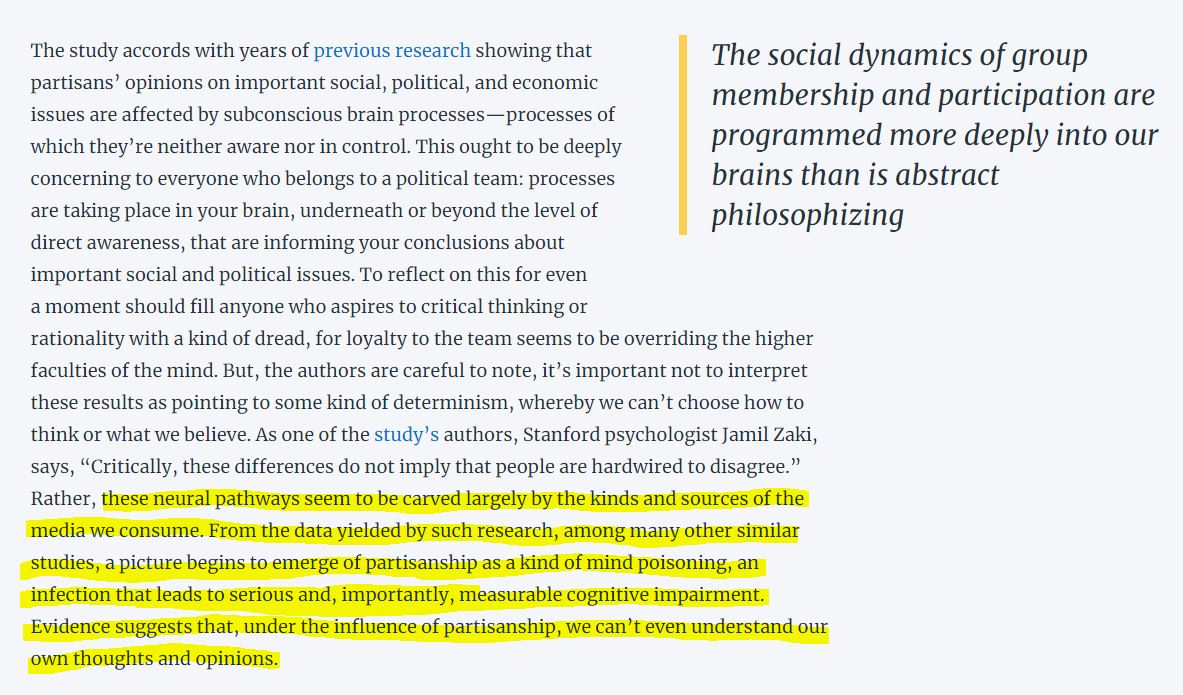
1. On Partisanship
Party loyalties hinder the brain’s ability to get a handle on reality. This article brings together some recent research in a remarkably illuminating way. Let us ponder a few key points.
libertarianism.org/articles/parti…
Party loyalties hinder the brain’s ability to get a handle on reality. This article brings together some recent research in a remarkably illuminating way. Let us ponder a few key points.
libertarianism.org/articles/parti…
2. In their 2018 study of why and how partisanship impairs the brain’s ability to process information objectively, NYU researchers Jay J. Van Bavel and Andrea Pereira note that “partisanship can alter memory, implicit evaluation, and even perceptual judgments.”
3. The researchers locate this neural polarization in the part of the brain known as the dorsomedial prefrontal cortex, a region associated with understanding and formulating narratives.
4. These neural pathways seem to be carved largely by the kinds and sources of the media we consume. From such research, a picture begins to emerge of partisanship as a kind of mind poisoning, an infection that leads to serious and measurable cognitive impairment. 

5. Evidence suggests that, under the influence of partisanship, we can’t even understand our own thoughts and opinions. Once one has chosen and joined a team, one has very little control over one's own thoughts.
6. When they are introduced, new data are distorted, misinterpreted, or discarded based on their consistency with what we may describe as a program running in the background: partisanship leads the team member into a cognitive position of unconscious self‐deception.
7. If citizens better understood the brain mechanics of the cognitive impairment and self‐deception brought on by partisanship, they’d be positioned to make better decisions. Research has shown that “reflecting on how we make decisions leads to better decisions.”
8. At this juncture, it is important to underline the fact that when we speak of partisanship, we are not speaking of ideology; the relationship between partisan identification and political ideology is complicated, the connection between the two not particularly strong.
9. Ideologues tend to think systematically, and the philosophical contents of their beliefs are deeply important to them. What is important to the partisan is not what they believe, but that they align their beliefs with those of their team or in-group.
10. Americans tend to vastly overestimate the differences in political ideology and policy preferences between Democrats and Republicans.
11. In fact, most Americans are not at all ideological, can’t describe ideologies accurately (as their proponents would describe them), and have almost no information on either the history of ideas or the empirical evidence that bears on particular political or policy questions.
12. Interestingly, partisanship doesn’t necessarily seem to be about politics in the philosophical sense, as “people place party loyalty over policy, and even over truth.” There are actually relatively weak correlations between partisan identity and concrete policy preferences.
13. In fact, strong partisanship is necessarily an impediment to ideological thinking insofar as ideology is predicated on an integrated and consistent approach to policy questions, as against the blind, team‐rooting approach associated in the literature with partisanship.
14. Ideologues, whatever their flaws, hold political actors and government bodies to account. Partisans change positions readily and shamelessly, depending on anything from who is in the White House, to the vagaries of party leaders, to what is perceived as popular at the moment.
15. Further, individual Americans’ political opinions are remarkably unstable over time, vacillating between glaring contradictions, relying on a confused amalgam of elite opinions.
16. Partisanship rather seems to be a holdover from humankind’s history of tribal loyalty, with “selective pressures having sculpted human minds to be tribal.” That is, evolution selected for just the kinds of cognitive biases we find in partisans on both sides today.
17. A recent paper published by the American Psychological Association suggests that from a cognitive and psychoneurological standpoint, partisans of the left and right are much more like each other than they are like nonpartisans.
18. Partisans of all stripes show lower levels of cognitive flexibility. Importantly, even when processing information that has no political character, they're more dogmatic, less adaptable, and less able to complete tasks that require an ability to adapt to novel circumstances.
19. Partisanship quite literally makes one dumb—or is it that dumb people are just more likely to be committed partisans? Zmigrod is careful to point out that the study can’t give us the answer to that question, that we would need longitudinal studies to understand the causality.
20. In a groundbreaking study, a team of researchers led by the University of Exeter’s Darren Schreiber attempted to address the lack of brain imaging research specifically aimed at better understanding nonpartisans.
21. The study found that nonpartisans’ brains are different from those of their brainwashed brethren, particularly in “regions that are typically involved in social cognition.”
medicalresearch.com/author-intervi…
medicalresearch.com/author-intervi…
22. It may be that the next stage in human evolution will involve rewiring our brains to accept the fact that current groups are artificially and arbitrarily defined—that all human beings are one people.
23. For just as there is harmful, toxic tribalism, there is also socially beneficial, cooperative, cosmopolitanism. As social policy expert Elizabeth A. Segal writes, “Ultimately our goal should be to build the tribe we all belong to: that of humanity.”
24. If we can understand and think clearly through partisanship, we can begin to build a freer world based not on arbitrary divisions and compromised reasoning, but on mutual respect and renewed emphasis on rigorous critical thinking.
The End
The End
• • •
Missing some Tweet in this thread? You can try to
force a refresh



